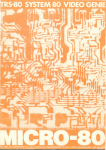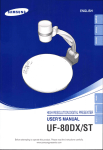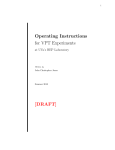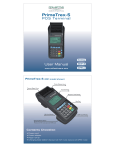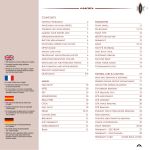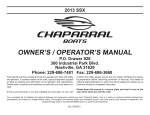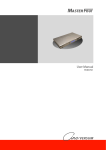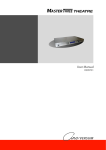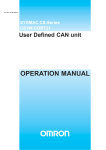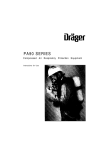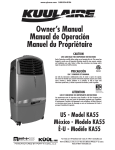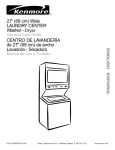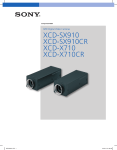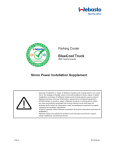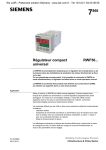Download USER`S MANUAL - Smith-Root
Transcript
Since 1964, the leader in effective, safe and reliable products for fisheries conservation. Knowledgeable biologists depend upon Smith-Root equipment. USER’S MANUAL BP-1.5 POW PULSER SMITH-ROOT, INC. Products for Fisheries Conservation WWW.SMITH-ROOT.COM USER’S MANUAL Contents Introduction................................................... 1 The BP-1.5-POW Pulsers............................... 2 Control Network............................................ 3 Supported Waveforms................................... 3 Front Panel.................................................... 4 Back Panel..................................................... 4 Version 2.0 POW Barrier Pulsers.................... 7 Restoring Barrier Operation........................... 8 Installation..................................................... 8 Specifications................................................. 9 Items manufactured by companies other than Smith-Root carry the original manufacturer’s warranty. Please contact product manufacturer for return instructions. All Smith-Root, Inc. manufactured products are covered by a one year warranty. Credit & Refund Policy: Customers returning equipment, in new condition, will be given credit to the applicable VISA/Master Card account within five days from the date of the return. A return authorization must accompany returns. Valid equipment returns include, but are not limited to, ordering incorrect equipment, funding deficits, and defective equipment returned for reimbursement. All returns are subject to a restocking fee and applicable shipping charges. The restocking fee is figured at 10% of the purchase price but not less than $20.00. Customers receiving equipment in damaged condition will be referred to the shipping company for insurance reimbursement. Rev. 042705-010 Control # __________________ 2009 I Typical barrier site with electrode array, building, pulser racks and FBTCS control console. Introduction Electric fish barriers have been employed for many years to guide migrating fish away from protected waterways or water hazards. By charging the water with enough electricity to stun the fish, up stream '&&"FIG $RAWNBY$AVID+IDD migrations can be easily blocked since a stunned fish cannot swim and will be swept back down stream by -ODIFIEDBY2ICHARD,INDSAY the water flow. Down stream migrations are more VERSION difficult to block since the electric field must produce enough irritation to keep the fish out of the barrier area without actually stunning them. In both cases, the way the electric current is applied to the water must be tightly controlled so as to produce the desired response from the fish without injuring them. Most early methods of charging the water used crude switching of AC line power. AC (alternating current) has been found to be much more damaging to fish than DC (direct current), so rectified AC (or pulsed DC) was tried. However, because of the rounded shape of this type of waveform, more power had to be applied to the water to produce the stunning effect, and little irritation could be felt by the fish before they were overcome by the charge, resulting in poor performance and damage to sensitive fish species. As concern grew over protecting endangered fish, it became obvious that better methods for applying the electric charge to the water were needed. To date, the most effective waveforms seem to be narrow DC pulses with quick rising edges and duty cycles (the ratio of on to off times) much less than 50%. This kind of waveform produces the greatest irritation to the fish and causes the least amount of harm when used properly. However, the actual parameters of this kind of waveform still vary depending on the direction of fish migration, the average size of the fish, and other factors specific to the particular barrier implementation. For this reason, Smith-Root has created a line of pulse generators with very flexible and accurate control of the output pulse parameters. 1 www.smith-root.com USER’S MANUAL INTRODUCTION The BP-1.5-POW Pulsers This line of barrier pulse generators (Pulsers) incorporates Smith-Root’s patented Programmable Output Waveform (POW) technology. A built-in computer controls and monitors the output waveforms, and can send the operational status of the unit to remote monitoring equipment. The units can be connected in series to charge large, multiple electrode, barrier arrays, and their output waveforms can be synchronized for maximum effectiveness. They produce a wide range of DC pulse outputs to give more stopping power with less stress to fish. The microprocessor in each POW pulser has direct control over all timing parameters of the output pulse waveforms, so a variety of waveforms can be generated without changes to the hardware. Highly reliable capacitive energy storage and solid-state power switching technology is employed in all POW Pulsers. This allows the units to maintain high available output power, reduce power line noise caused by intermittent loading and allows true square pulse waveforms to be generated. 2009 2 Control Network Due to the complex nature of these units, most controls have been eliminated and replaced with a fiber-optic data communications network. Control and monitoring information is sent over this network to a central monitoring computer, such as the Fish Barrier Telemetry and Control System (FBTCS). Once configured, POW Pulsers can be operated without being connected to the data network, since all settings information is stored in nonvolatile memory inside each unit. A separate fiber-optic network is provided to transmit triggering signals used in synchronizing the output waveforms of two or more POW Pulsers. When multiple POW Pulsers are connecated in this way, one becomes the master source of the synchronizing information and the others become slaves to that information. If the current master Pulser should fail, one of the other POW Pulsers in the system will become master. This provides redundancy and helps keep the barrier functional Supported Waveforms Below are diagrams and descriptions of the types of output waveforms supported by the POW Pulsers. The first two are included as standard features. &REQUENCY 0ERIOD 0ERIOD "ETWEEN7IDTH 6OLTS 6OLTS 0ERIOD 7IDTH 0ULSE7IDTH "URST0ULSES "URST2ATE 0ERIOD 4IME 4IME 3TANDARD0ULSE 'ATED"URSTOF0ULSES Standard Pulse: A regular pattern of on/off times. The width and period of the pulses are selected to produce the desired response in the fish. Gated Burst: A group of pulses followed by a longer off-time. This is often just as effective as standard pulses, but usually requires less power to achieve the same results. It may also be less stressful to the fish, particularly when trying to stun them. Other Waveforms: Since the output is directly controlled by computer algorithms, almost any type of pulse waveform can be generated, limited only by the rate the output can be switched on and off. Sequences of pulses sweeping from wide-to-narrow width, or sequences sweeping from high-to-low frequency, can be implemented on special order. 3 www.smith-root.com USER’S MANUAL PANEL ITEMS Front Panel There are three indicator lights on the front panel of all POW Pulsers. The Green Power light indicates when the unit is powered up. The Red Trigger light flashes when an output pulse has been generated. The Red Fault light indicates that the output has been automatically turned off, even though the power to the unit is still on. There are four conditions that can cause the Fault light to come on: Programmed Shutdown: The FBTCS computer has instructed the POW Pulser to turn off it’s output. This is provided so the FBTCS can temporarily shutdown the barrier if someone enters the area and Front Panel Indicator Lights is in danger of being shocked. Average Power Overload: The power being used exceeds the safe operating limits of the unit. This can be corrected by using a waveform with a lower duty cycle (ratio of on to off times). Peak Current Overload: The maximum electrical current produced by the unit exceeds safe operating limits. This is usually caused by a short circuit of the Pulser’s output. Over Temperature Fault: The temperature of the transformers in the unit is too high. If no other fault conditions are detected, this fault will clear itself when the temperature falls within the acceptable range. The first three fault conditions will last until the Pulser has been reset, either by a command from the FBTCS or by turning the Pulser power off and then on again. Once reset, the Pulser will try generating output pulses again. If the fault was caused by an overload, a reset is not advised until the cause has been corrected, as this places undue stress on the output switching components of the Pulser. Rear Panel The picture below shows the typical back panel of a POW barrier Pulser. 34 56 At the top center of this panel are two 16 position rotary switches marked “Pulse Mode” and “Unit A F 01 2 BCD E 789 ON PULSE MODE OFF UNIT ADDRESS WARNING CIRCUIT BREAKERS RISK OF ELECTRICAL SHOCK. READ INSTALLATION AND OPERATING INTRUCTIONS BEFORE USING. FOR INDOOR USE ONLY - DO NOT EXPOSE TO RAIN OR MOISTURE. TRIGGER DATA AVERTISSEMENT OUTPUT DC pulse 600A 350V 1.5kW RISQUE DE CHOC ÉLECTRIQUE. LISEZ L'INSTALLATION ET LES CONSIGNES D'UTILISATION AVANT UTILISATION. POUR L'USAGE D'INTÉRIEUR SEULEMENT - N'EXPOSEZ PAS À LA PLUIE OU À L'HUMIDITÉ. ATTENTION 1+ 2+ TO REDUCE THE RISK OF ELECTRICAL SHOCK, DO NOT REMOVE COVER. REFER SERVICING TO QUALIFIED SERVICE PERSONNEL. BP-1.5 POW PROGRAMMABLE OUTPUT WAVEFORM ATTENTION PULSED VOLTAGE MACHINE POUR RÉDUIRE LE RISQUE DE CHOC ÉLECTRIQUE, N'ENLEVEZ PAS LA COUVERTURE. RÉFÉREZ-VOUS L'ENTRETIEN AU PERSONNEL DE SERVICE QUALIFIÉ. 1- 2- FISH BARRIER PULSATOR U.S. Patent Nos. 5,327,854 and 4,750,451. Canada Patent No. 1,304,442. INPUT: 230/240 Volts 10 Amp AC 50/60 Hz. 1 Φ. IP31 www.smith-root.com INPUT: 230/240 Volts 10 Amp AC 50/60 Hz. 1 Φ. AUX. ALARM THIS PRODUCT IS PROVIDED WITH A MEANS FOR GROUNDING METAL PARTS THROUGH THE GROUNDING PIN OF THE POWER SUPPLY CORD. DO NOT REMOVE THE GROUNDING PIN. C NO NC CE PRODUIT EST ÉQUIPÉ D'DES MOYENS POUR FONDRE DES PIÈCES EN MÉTAL PAR LE PIQUET DE MISE À LA TERRE DE LA CORDE D'ALIMENTATION D'ÉNERGIE. N'ENLEVEZ PAS LE PIQUET DE MISE À LA TERRE. SERIAL NO. Rear Panel layout 2009 4 F 01 2 A 789 PANEL ITEMS Cont. 34 56 BCD E Address”. The unit must be off before adjusting the position of these switches. They are inset and can only be adjusted by using a small, flat blade screw driver or other similar tool. The Pulse Mode switch of all pulsers must be set to the same value. ON The Unit Address must be set to unique values for each Pulser in a barrier system. If two Pulsers in a barrier system have the UNIT PULSE same Unit Address, the FBTCS could not talk to them over the ADDRESS MODE data network and they may also cause other communication problems. Pulse Mode and Unit Address Switches The main power switch and circuit breakers are located in OFF the top left corner of the back panel. There are two circuit breakers WARNING T BREAKERS for normal 240 VAC operation, only one inRISK OF ELECTRICAL SHOCK. PULSÉ a 120 VAC configuration, and three in aTENSION custom MACHINE 3 phase READ INSTALLATION AND OPERATING INTRUCTIONS BEFORE USING. connection (1.5KW model only). FOR INDOOR USE ONLY - DO NOT EXPOSE TO RAIN OR MOISTURE. The high power output connectors are located just below the circuit breakers, with Red being the AVERTISSEMENT positive outputs and Black marking the negative outputs. The positive outputs are tied together internally, RISQUE DE CHOC ÉLECTRIQUE. while the negative outputs come off independent solid-state switches. This allows the outputs to be tied LISEZ L'INSTALLATION ET LES CONSIGNES D'UTILISATION AVANT UTILISATION. together for greater combined power to onePOUR pair L'USAGE of electrodes, or used independently to charge D'INTÉRIEUR SEULEMENT - N'EXPOSEZ PAS À LAthree PLUIE OU À L'HUMIDITÉ. lse 600A 350V 1.5kW electrodes with the center electrode being the positive one. The output power from these Pulsers is isolated from chassis and earth ground, so several unitsATTENTION can be connected together to charge larger electrode arrays. Output voltage is determined by wiring of the transformers and mustSHOCK, be set DO at the by TO internal REDUCE THE RISK OF ELECTRICAL NOT factory REMOVEor COVER. qualified Smith-Root personnel. REFER SERVICING TO QUALIFIED SERVICE PERSONNEL. 2+ The power input is just below the output connectors. On the bottom center of the panel is a set ofATTENTION screw terminals marked “Aux. Alarm”. These connections POUR RÉDUIRE LE RISQUE DE CHOC ÉLECTRIQUE, PASbut LA COUVERTURE. are for use with barrier systems that do not employ a central monitoring computer like N'ENLEVEZ the FBTCS, RÉFÉREZ-VOUS L'ENTRETIEN AU PERSONNEL DE SERVICE QUALIFIÉ. which still need some way of signaling an alarm if there is a problem with the Pulsers. The Aux. Alarm terminals on the back of the unit provide access to a set relay contacts. Any circuit connected to these 2terminals must supply 24V or less at 1A or less AC or DC. NOTE: No power is supplied to these contacts from inside the pulser. At the top left corner of the back panel are the fiber-optic Data and Trigger network connectors. Fiber-optic network cables were chosen over normal wire ones due to their immunity to electromagnetic noise and the isolation they give between the high power Pulsers and the more sensitive monitoring INPUT: 240light Volts Hz. 1information Φ, 1.5 kW.over these cables, care must be taken to insure that computer. Since is AC. used50/60 to transmit no stray light can enter the network. These connectors require that a special rubber “plug” be placed AUX.is not ALARM in each hole, two per connector, if a trigger or data network connection used. Failure to fill these connector holes with either a WITH validA fiber-optic network cable connector or THIS PRODUCT IS PROVIDED MEANS FOR GROUNDING C these NOrubber NC plugs will result in PARTS THROUGH PIN OF THEto POWER poor orMETAL erratic behavior ofTHE theGROUNDING POW Pulser due stray light entering the connector. SUPPLY CORD. DO NOT REMOVE THE GROUNDING PIN. É D'DES MOYENS POUR FONDRE DES PIÈCES EN MÉTAL PAR LE PIQUET DE MISE À LA ALIMENTATION D'ÉNERGIE. N'ENLEVEZ PAS LE PIQUET DE MISE À LA TERRE. 5 www.smith-root.com USER’S MANUAL NETWORK Fiber-Optic Data Network Connections &IBER/PTIC$ATA.ETWORK#ONNECTIONS 4RANSMITER "LACK 2ECIEVER "LUE $ATA 0/7 0ULSER 4RANSMITER "LACK &IBER#ABLE 23!DAPTER 4RANSMITER "LACK 4RIGGER $ATA 0/7 0ULSER 4RIGGER,OOP&IBER#ABLE 4RIGGER 2ECIEVER "LUE $ATA 0/7 0ULSER 4RANSMITER "LACK 4RIGGER 2ECIEVER "LUE $ATA 0/7 0ULSER 4RANSMITER "LACK 4RIGGER 2ECIEVER "LUE $ATA 0/7 0ULSER 4RANSMITER "LACK 4RANSMITER "LACK 2ECIEVER "LUE 2ECIEVER "LUE 4RANSMITER "LACK &IBER#ABLE 2ECIEVER "LUE -ASTER #ONNECTION 4RANSMITER "LACK 2ECIEVER 4RANSMITER "LUE "LACK &IBER#ABLE 4RANSMITER "LACK #/- 2*TO $"OR $" !DAPTER /PTIONAL ,APTOP #OMPUTER ./4%4HE&"4#3ANDTHE/PTIONAL ,APTOP#OMPUTERCANNOTBECONNECTED ATTHESAMETIME 2ECIEVER "LUE )-0/24!.4!LLUNUSED&IBER/PTIC 2ECEIVER0ORTSPARTICULARLYTHOSEON THE&"4#3THE3TAR#ONCENTRATORAND THE0ULSER4RIGGERINPUTS-534HAVE ALIGHTBLOCKINGRUBBERPLUGINSTALLEDTO ALLOWTHENETWORKAND0ULSERSTOWORK PROPERLY,IGHTLEAKSARETHEMOST COMMONPROBLEMWITHFIBEROPTICS 2ECIEVER 4RANSMITER "LUE "LACK &IBER#ABLE 4RANSMITER "LACK 0HONE#ORD 2* *ACK 2ECIEVER "LUE .ETWORK )NTERFACE &"4#3 #OMPUTER 2ECIEVER 4RANSMITER "LUE "LACK &IBER#ABLE 2ECIEVER "LUE !LLNETWORKDEVICESMUSTBESETTO DIFFERENT ADDRESSESINORDERTOBE SEENBYTHE&"4#3 5NUSEDCONNECTORSWITH RUBBERLIGHTBLOCKINGPLUGS /PTIONAL 3LAVE3TAR #ONCENTRATOR ,APTOP #OMPUTER 3TAR#ONCENTRATOR 2ECIEVER 4RANSMITER "LUE "LACK &IBER#ABLE 3LAVE #ONNECTIONS 4RANSMITER "LACK #/- 2*TO $"OR $" !DAPTER ./4%!DAPTERPOWERMUSTBE TURNEDONTOFUNCTION"ATTERY WILLONLYLASTAFEWHOURSUNDER HEAVYUSE ./4%!TRIGGERLOOPMUSTBEUSED TOSYNCHRONIZEMULTIPLEPULSERS 2ECIEVER "LUE 0HONE#ORD 2* *ACK 2ECIEVER "LUE #ONNECTOR 4RANSMITER "LACK 2ECIEVER "LUE (UMP 2ECIEVER "LUE )-0/24!.4!LL&IBER/PTICCONNECTORS MUSTBEFULLYSEATEDFORTHENETWORKTO FUNCTION4HECONNECTORSAREPOLARIZED ANDCANONLYBESNAPPEDINPLACEONE WAY 4RANSMITER "LACK -ASTER)NPUT 4RANSMITER "LACK &IBER#ABLE 2ECIEVER "LUE WARNING: Do Not change data or trigger network connections while any POW Pulsers in the system are still running. Signals caused by stray light into a connector will be sent to all units on the network and can cause false triggers and other problems with the Pulsers. 2009 6 B C DE F 0 1 2 A A B C DE F 0 1 2 3 4 5 6 7 8 9 7 8 9 FF With Version 2.0 firmware, our POW barrier pulsers have a manual method for setting the output waveform parameters. This is done with the Pulse Mode Switch. The Unit Address switch still selects the network address for the unit, which can now only range from 0 through 15 (0-F Hex). The Pulse Mode switch now selects from a table of 16 preset waveforms. All of these preset waveforms can be modified by network commands, and the changes will be retained through a power reset. A diagram of these switches and the factory default settings for these preset waveforms are shown below: 3 4 5 6 N Version 2.0 POW Barrier Pulsers PULSE MODE UNIT ADDRESS WARNING BREAKERS RISK OF ELECTRICAL SHOCK. The Default Waveform Table READ INSTALLATION AND OPERATING INTRUCTIONS BEFORE USING. FOR INDOOR USE ONLY DO NOT Frequency EXPOSE TO RAIN OR MOISTURE. Pulse Mode Pulse Type Pulse Width Pulse Power-up State 0 Standard 5ms 2Hz OFF AVERTISSEMENT RISQUE DE CHOC ÉLECTRIQUE. 2Hz 1 Standard 5ms ON LISEZ L'INSTALLATION ET LES CONSIGNES D'UTILISATION AVANT UTILISATION. Standard 7ms D'INTÉRIEUR SEULEMENT 2Hz - N'EXPOSEZ PASON POUR L'USAGE À LA PLUIE OU À L'HUMIDITÉ. e 600A 350V 1.5kW 2 3 Standard 10ms 2Hz ON 4 Standard 5ms 2.5Hz ON ATTENTION TO REDUCE THE RISK OF ELECTRICAL SHOCK, DO NOT REMOVE 5 Standard 7ms 2.5Hz ON COVER. REFER SERVICING TO QUALIFIED SERVICE PERSONNEL. 2+ 6 Standard 10ms 2.5Hz ON 7 Standard 5ms 3Hz ON ATTENTION POUR RÉDUIRE ÉLECTRIQUE, N'ENLEVEZ 8 Standard 7ms LE RISQUE DE CHOC 3Hz ONPAS LA COUVERTURE. RÉFÉREZ-VOUS L'ENTRETIEN AU PERSONNEL DE SERVICE QUALIFIÉ. 9 Standard 10ms 3Hz ON A (10) Standard 1ms 5Hz ON 2B (11) Standard 3ms 5Hz ON C (12) Standard 5ms 5Hz ON D (13) Standard 1ms 10Hz ON E (14) Standard 3ms 10Hz ON INPUT: 240 Volts AC. 50/60 Hz. 1 Φ, 1.5 kW. F (15) Standard 5ms 10Hz ON AUX. ALARM THIS PRODUCT IS PROVIDED WITH A MEANS FOR GROUNDING METAL Note that the first switch position powers in PARTS THROUGH THE GROUNDING PIN OF THE(0) POWER SUPPLYup CORD. DO NOT REMOVE THE GROUNDING PIN. power up in the “Output ON” state. In barriers that C state NOwhere NC as all other positions the “Output OFF” must be automatically turned off for safety reasons, thisCEfirst switch position is the default so DES the PIÈCES barrier PRODUIT EST ÉQUIPÉ D'DES MOYENS POUR FONDRE EN remains off until the controller determines that it is MÉTAL PAR LEitPIQUET safe to turn on. DE MISE À LA TERRE DE LA CORDE D'ALIMENTATION D'ÉNERGIE. N'ENLEVEZ PAS LE PIQUET DE MISE À LA TERRE. 7 www.smith-root.com USER’S MANUAL MAINTENANCE Restoring Barrier Operation on Version 2.0 Pulsers In the event that the barrier controller fails while the pulsers are in the “Output OFF” state, just turn all the pulsers off and set the Pulse Mode Switch on each pulser to one of the positions other than zero. Then turn the power for each pulser back on, starting with the first one (the one with the lowest network address). All units should start pulsing after a short startup delay. All pulsers should be set to the same Pulse Mode Switch position. You should start with low switch numbers and work your way up to higher numbers until the desired output power level is reached (the fish are repelled without being harmed). Remember, all changes to these switch settings should be made with the pulsers OFF! Installation Please consult with Smith-Root personnel for information on proper installation and configuration of these POW pulsers. We will do our best to examine your situation and provide a solution that meets your needs. Maintenance Should the power cord become damaged, it must be replaced by Smith-Root or our service agent with a special cord available from Smith-Root. Cleaning The BP-1.5 enclosure may be cleaned with warm water and a mild soap solution. Spray the solution on the area to be cleaned and then wipe with a soft cloth. CAUTION: Do not use solvents on the case of the BP-1.5 as they may cause permanent damage to the paint and decals. 2009 8 Specifications Input voltage Standard 240 Volts, single phase, 50-60Hz AC Output voltage (Pulsed DC) 56, 112, 168, 224, 280, 336 V Input voltage, special order Maximum input current Maximum output energy Output insulation rating Output current, maximum Pulse width Pulse Frequency or Burst Rate Dimensions Weight Operating temperature Capacitor bank 120 Volts, single phase, 50-60Hz AC 240 Volts, three phase, 50-60Hz AC 10 Amps 1860 Joules 5,000 Volts for 1 minute 1,200 Amps 0.15 to 10.0 Milliseconds 0.1 to 10.0 Hz 16.5”W x 10.5”H x 27”D 120 Pounds 0–40°C (32–104°F) Relative humidity 5 to 95 percent, non-condensing. 33,000 μF * Specifications subject to change without notice 9 www.smith-root.com SMITH-ROOT, INC. 14014 NE Salmon Creek Ave. Vancouver, WA 98686 USA 360.573.0202 Voice 360.573.2064 FAX info@smith-root.com www.smith-root.com












